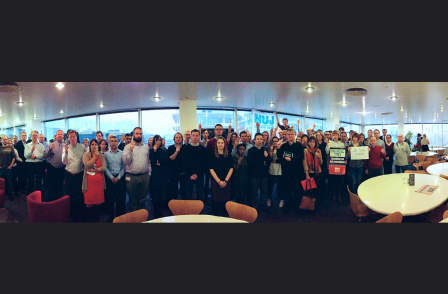
It takes something for journalists who exist on a daily diet of murder and mayhem to be moved to make the public displays of solidarity we saw throughout the UK yesterday.
Holding pens aloft in a silent show of defiance at 11am the message was simply: Je suis Charlie.
Yet no matter how heartfelt that sentiment, the elephant in the room remains the fact that the self-censorship prompted by the extremists who murdered nine editorial staff, one worker and two police on Tuesday at the Charlie Hebdo office continues.
The leading theory is that the magazine was targeted because it published cartoons which apparently depicted the Prophet Muhammad.
Even though republishing such images will genuinely offend some Muslims, it is difficult to tell this story without showing them.
Cartoons which seriously offend Jews, Christians and other faiths are published every day. But when a prospective complainant is holding a Kalishnikov their argument has rather more force.
Yesterday, The Times was the only national newspaper to publish one of the contentious Charlie Hebdo cartoons.
In a panel on page four, they included four small front covers one of which – from 2011 – was the front which apparently prompted Charlie Hebdo's previous offices to be destroyed by a firebomb.
The issue was "guest edited" by Muhammad with a depiction of him on the front page saying: "100 lashes of the whip if you don't die laughing".
The panel of four front pages also included two which would have been offensive to many Christians.
It strikes me as a serious way of telling the story without being disrespectful to Muslims who might take offence. As the caption makes no reference to the fact the front page was apparently intended to depict Muhammad most readers would in any case have been unaware.
Whereas newspapers in France and Germany have produced many of the controversial Charlie Hebdo cartoons, UK newspapers have so far on the whole declined to do so.
Editors have to make daily assessments of risk versus reward on what they choose to publish, and when the risk (however small) is the danger that a fanatic could murder some of your stuff it is a difficult decision to justify.
But haven't the terrorists won a little victory when we are still clearly intimidated from producing the contentious images at the heart of this story?
And yes, I know I haven't reproduced the relevant front page from Charlie Hebdo here. Below is the Charlie Hebdo front cover published in the aftermath of the 2011 firebombing.
It depicts a staffer from the magazine kissing a Muslim man and carries the headline: "Love is stronger than hate".

Email pged@pressgazette.co.uk to point out mistakes, provide story tips or send in a letter for publication on our "Letters Page" blog
